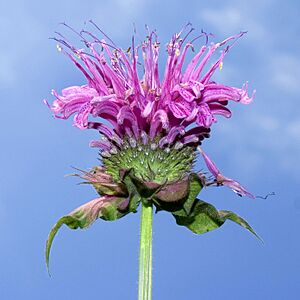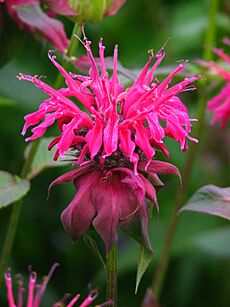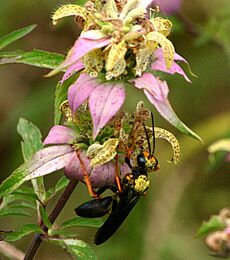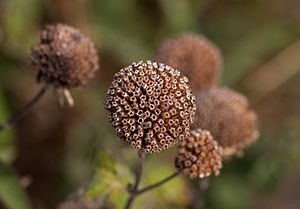Monarda facts for kids
Quick facts for kids Monarda |
|
|---|---|
 |
|
| Monarda didyma | |
| Scientific classification |
|
| Kingdom: | Plantae |
| Clade: | Tracheophytes |
| Clade: | Angiosperms |
| Clade: | Eudicots |
| Clade: | Asterids |
| Order: | Lamiales |
| Family: | Lamiaceae |
| Subfamily: | Nepetoideae |
| Tribe: | Mentheae |
| Genus: | Monarda L. |
| Type species | |
| Monarda fistulosa |
|
| Synonyms | |
|
|
Monarda is a group of flowering plants that belong to the mint family. These plants are only found naturally in North America. People often call them bergamot, bee balm, horsemint, or oswego tea. The name "bergamot" comes from the sweet smell of their leaves, which reminds some people of the bergamot orange. The plant group was named after a Spanish botanist, Nicolás Monardes. He wrote a book in 1574 about plants from the Americas.
Contents
What is Monarda?
Plant Features
Monarda plants can be annuals (meaning they live for one year) or perennials (meaning they grow back every year). They are herbaceous plants, which means they have soft stems. These plants grow straight up, usually between 20 and 90 centimeters tall.
Leaves and Stems
Monarda plants have thin, saw-edged, spear-shaped leaves. These leaves grow in pairs on the square-shaped stem. They are usually smooth or have a few hairs. Each leaf is about 7 to 14 centimeters long.
Beautiful Flowers
The flowers of Monarda are tube-shaped and look the same on both sides. They have a narrow upper part and a wider lower part. Wild Monarda plants usually have single flowers. However, some garden varieties have double flowers. Each flower has both male and female parts. They also have two stamens, which are the parts that hold pollen.
The flowers grow in crowded, head-like clusters. These clusters are found at the top of the stem or where leaves meet the stem. They often have special leaves called bracts that look like petals. Monarda flowers come in many colors. Wild types often have red, pink, and light purple flowers. For example, Monarda didyma has bright red flowers. Monarda fistulosa has pink flowers. Monarda citriodora and Monarda pectinata have pale purple flowers.
Different types of Monarda can mix naturally, creating new kinds. These mixed plants are called hybrids. Hybrids are also common in gardens. If you plant seeds from a hybrid, the new plants might not look exactly like the parent plant.
How Monarda is Used
All types of Monarda plants have leaves that release a spicy, sweet-smelling essential oil when crushed. One study found that M. didyma had the most oil.
Traditional Uses by Native Americans
Many Native American groups, like the Blackfoot, Menominee, Ojibwa, and Winnebago, have used Monarda plants for a long time. They used species like Monarda fistulosa and Monarda didyma as traditional medicines.
The Blackfoot people knew that Monarda had strong germ-fighting power. They used it as a paste to help with skin problems and small cuts. Native Americans and early settlers also used Monarda to ease stomach aches and breathing problems. They made an herbal tea from the plant. This tea helped with mouth and throat infections, like those from tooth decay or gum problems. Bee balm naturally contains a germ-fighting ingredient called thymol. This is the main active ingredient in some modern mouthwash products. The Winnebago people drank bee balm tea as a general stimulant to give them energy. Native Americans also used bee balm to help with digestion and prevent gas.
Cooking with Monarda
Monarda leaves and buds can taste a bit bitter because of the thymol. However, they also taste like a mix of spearmint, peppermint, and oregano. Native Americans traditionally used bee balm to flavor wild foods, especially birds. These plants grow all over North America. You can find them in wet meadows, on hillsides, and in forest clearings. They grow up to about 1,500 meters high.
Growing Monarda in Your Garden
Monarda plants grow best in sunny spots. They like soil that is moist but doesn't hold too much water. If planted in partial shade, they tend to spread out more and have fewer flowers. Gardeners often use Monarda in flower beds. They help attract hummingbirds, bees, and other helpful insects. These insects can also control garden pests. Monarda plants can sometimes get a white powdery disease on their leaves. This happens in high humidity, especially if they don't have good air circulation.
Popular Garden Varieties
Garden varieties, also called cultivars, come in many colors. They range from deep red to purplish-blue and different shades of pink. These garden types are usually not as strong as the wild plants. Some special varieties have been created. They produce a lot of essential oil for flavor or medicine.
Here are some popular garden varieties that have won a special award. This award is called the Royal Horticultural Society's Award of Garden Merit:
- 'Beauty of Cobham' (pink)
- 'Gardenview Scarlet'
- 'Marshall's Delight' (pink)
- 'Squaw' (red)
- 'Talud' (pink)
The main collection of Monarda plants in the UK is at Glyn Bach Gardens. This garden is located in Pembrokeshire. In 2019, Carole Whittaker from Glyn Bach Gardens became the official person. She registers new Monarda plant varieties. As of October 2025, she recognizes over 100 different varieties.
Monarda and Wildlife
Monarda plants are an important food source for some insects. For example, the larvae (caterpillars) of certain Lepidoptera species eat Monarda. This includes a type of moth called case-bearer moths. One specific moth, Coleophora monardae, only eats Monarda plants. Other moths, Coleophora heinrichella and Coleophora monardella, only eat the M. fistulosa type of Monarda.
Monarda's Plant Family
Monarda belongs to a group called Mentheae. This group is part of the mint family. Scientists use DNA studies to understand how plants are related. However, the exact relationships within this group are still being studied. Other plants like Blephilia and Pycnanthemum are close relatives of Monarda.
Different Kinds of Monarda
The Monarda group is divided into two main smaller groups. These are called Monarda and Cheilyctis. They are easy to tell apart by their different features.
Here are some of the different species (types) of Monarda:
- Monarda bartlettii - found in Tamaulipas, Veracruz (Mexico)
- Monarda balmettii – also known as fools balm - found in the northwest United States
- Monarda bradburiana – also known as eastern beebalm - found in the mid Mississippi Valley
- Monarda citriodora – also known as lemon beebalm or lemon-mint - found in the southern United States and northern Mexico
- Monarda clinopodia – also known as white bergamot or basil beebalm - found in the eastern United States, especially the Appalachian Mountains
- Monarda clinopodioides – also known as basil beebalm - found in Kansas, Oklahoma, Texas, Louisiana
- Monarda didyma – also known as Oswego tea, scarlet beebalm, fragrantbalm, or mountain-mint - found in the eastern United States (especially the Appalachian Mountains) and eastern Canada
- Monarda eplingiana - found in Coahuila (Mexico)
- Monarda fistulosa – also known as wild bergamot, mintleaf beebalm, horse-mint, or purple beebalm - found across most of the United States and Canada, and in Tamaulipas, Nuevo León (Mexico); also grown in China and other places
- Monarda fruticulosa – also known as spotted beebalm - found in southern Texas
- Monarda humilis - found in New Mexico
- Monarda lindheimeri – also known as Lindheimer's beebalm - found in Texas, Louisiana, southwestern Arkansas
- Monarda luteola - found in northeastern Texas, southwestern Arkansas
- Monarda maritima – also known as seaside beebalm - found along the coastal plain of Texas
- Monarda media – also known as purple bergamot - found in Ontario (Canada) and the eastern United States
- Monarda × medioides - a natural hybrid found in Georgia, Indiana
- Monarda pectinata – also known as plains beebalm, pony beebalm, or spotted beebalm - found in the central and southwestern United States (Great Plains, Rocky Mountains, southwestern desert mountains)
- Monarda pringlei - found in Nuevo León (Mexico)
- Monarda punctata – also known as spotted beebalm, dotted monarda, or horse-mint - found in Quebec, Ontario (Canada), eastern and south-central United States, California, and northeastern Mexico
- Monarda russeliana – also known as redpurple beebalm - found in Texas, Oklahoma, Arkansas, Alabama, Mississippi, Kentucky
- Monarda stanfieldii – also known as Stanfield's beebalm - found in central Texas
- Monarda viridissima – also known as green beebalm - found in east-central Texas




